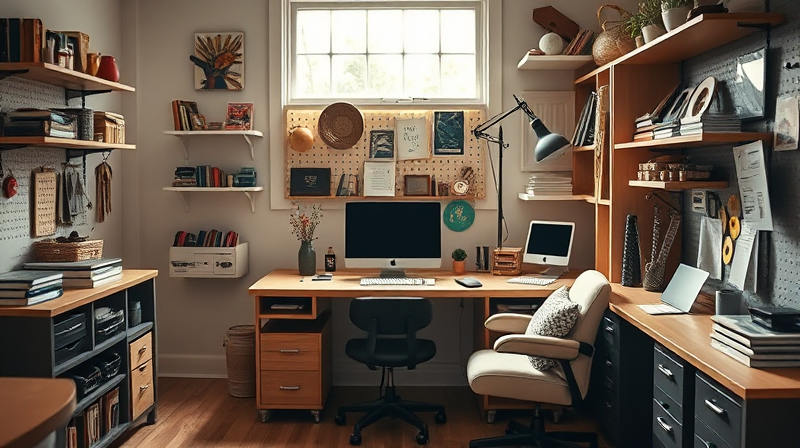Creating a space that inspires creativity and nurtures your passion for art, crafting, or DIY projects can truly transform your everyday routine. A home workshop isn't just about having a dedicated area; it's about building a sanctuary for your ideas, enhancing productivity and ultimately enriching your artistic journey. The process of setting up a workspace that works for you can be fulfilling when approached methodically.
In this article, we will explore practical tips and innovative ideas to help you design, organize, and personalize your creative haven. Whether you're a beginner looking to start small or an experienced artist seeking to upscale your environment, these steps will guide you through every stage of establishing a creative workshop inside your home.
Choose the Perfect Space
The first step in creating your creative workshop starts with selecting the right space. It could be a spare room, a part of your basement, a corner in the living room, or even a converted garage. Identifying a location with ample natural light is essential as it not only enhances your work but also elevates the overall atmosphere of your workshop.
Along with natural lighting, consider the space's ventilation and accessibility. A well-ventilated area is crucial if your projects involve chemicals or paints, while easy access ensures that you make the most of your space without any hindrances.
Plan an Efficient Layout
Once you have decided on the location, it's time to design the layout. Planning your layout involves understanding the workflow of your creative process and organizing your space in a way that supports it. Start by sketching your ideal workspace and placing key elements such as workbenches, storage areas, and equipment zones strategically.
- Workflow: Ensure there is a logical flow between work areas.
- Storage: Plan storage for your supplies, tools, and materials.
- Accessibility: Keep everything within reach to promote a smooth creative process.
This thoughtful arrangement will allow you to remain organized while working on projects and keeps your space clutter free.
Focus on Lighting and Power Sources
Proper lighting is the cornerstone of any effective workshop. An ideal creative workshop incorporates a mix of natural and artificial light to cater to all working conditions. Invest in task lighting where fine details are important, and blend it with ambient lighting for overall illumination.
In addition to lighting, addressing your power source needs is critical. Ensuring adequate power outlets will support your art tools, power devices, and any electronic equipment you use. If you work with heavy machinery or high-powered tools, consider installing a dedicated circuit to safeguard your workspace.
Invest in Versatile Furniture and Organized Storage
Choosing quality furniture that fits your creative style can dramatically impact your productivity. Opt for a sturdy workbench, comfortable seating, and adjustable tables that cater to the specific needs of your projects. Your furniture should blend functionality with ergonomics, ultimately creating a comfortable environment for long creative sessions.
Organization within your workshop is just as important as the physical setup. Design a storage system that keeps your tools and materials neatly arranged, using shelves, drawers, or even pegboards. A well-organized workshop not only looks appealing but also boosts efficiency since all items are at your fingertips.
Create Zones for Inspiration and Relaxation
There is more to a creative workshop than just work areas. A dedicated space for inspiration can be a powerful motivator. Set up an inspiration zone where you display your favorite art, mood boards, or input for future projects. This visual element fuels creativity and serves as a daily reminder of why you love your craft.
Additionally, consider incorporating comfort features that make your space inviting. Whether it is a cozy nook for reading and brainstorming, a small fridge for refreshments, or a surround sound system for relaxing tunes—the little touches make a big impact in creating a balanced workspace.
Ensure Comfort and Safety
For any prolonged creative session, comfort is paramount. Establish a space that keeps you physically at ease and safely engaged in your art. Maintain a cleaning station within your workspace to quickly manage messes and dispose of hazardous materials, especially when working with paints or solvents.
A well-ventilated environment is another safety aspect, particularly if you use materials that emit fumes. Consider incorporating fans or air purifiers as needed, ensuring your workspace remains safe and comfortable for extended periods.
Personalize Your Creative Sanctuary
Lastly, customize your workshop to reflect your artistic personality. As you progress in your creative journey, your needs may evolve, and so should your workspace. Personal touches, such as displaying your favorite creations or adding decor elements that inspire you, can enhance the functionality and appeal of your workshop.
Remember, there is no one-size-fits-all solution when it comes to design. Allow your creative spirit to guide you, making continuous improvements until your space perfectly reflects your individual style.
To conclude, establishing a creative workshop in your home isn't merely about setting up a physical space—it's about building a nurturing environment that encourages exploration, innovation, and personal growth. These steps provide you with a roadmap to tailor a workshop that not only supports your current projects but also inspires future artistic endeavors.
Embrace the opportunity to create a dedicated zone that aligns with your vision, and watch your creativity flourish every time you step into your personalized space.








